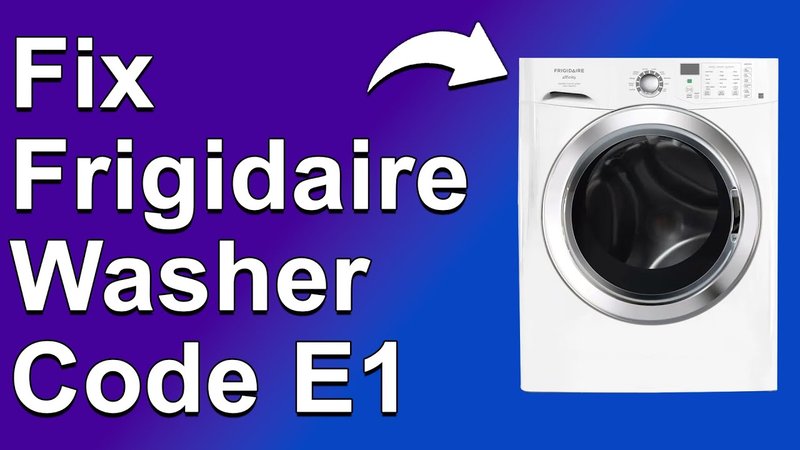
Here’s the deal: when you see an error code on your dishwasher, it’s much like your car’s check engine light—a signal that something’s amiss. The E1 error in Frigidaire dishwashers generally relates to a leakage issue. It’s like your dishwasher waving a red flag, indicating there might be a water leakage that could potentially lead to bigger problems. The key question, therefore, is whether it’s safe to ignore this alert and proceed with your dishwashing routine.
Understanding the E1 Error Code
Let’s delve deeper into what the E1 error code actually signifies. In simple terms, it’s your dishwasher’s way of telling you that it has detected a water leakage issue. Picture it as a vigilant security system in your home—always on the lookout for intruders and ready to sound the alarm at the first sign of trouble. Similarly, the E1 error is your dishwasher’s internal alarm system, alerting you to potential water escape, which could damage both the machine and your kitchen.
The E1 error might seem obscure, but it’s rooted in your dishwasher’s design. Inside, there’s a safety mechanism that monitors water levels and leakage. If it suspects water isn’t where it should be, it triggers this error to prevent further complications. Imagine a dog sniffing out danger way before you notice anything’s wrong. Wouldn’t you trust its instincts? Similarly, the E1 code is your early warning.
So, what causes this error? There are several possibilities. It could be due to a faulty door seal not holding water in, or perhaps a cracked hose letting water escape. It’s akin to filling a bucket with a hole in the bottom—no matter how slowly you pour, the water will always find its way out. Identifying the root cause of the E1 error is crucial to determining your next steps.
Assessing the Safety of Continued Use
Now, you might be wondering: is it okay to keep using the dishwasher with this error code? Well, here’s where caution comes into play. Continuing to use the dishwasher without addressing the issue is like choosing to drive your car with a flat tire. Sure, it might work for a bit, but you risk causing more damage and higher repair costs in the long run.
The main concern is water damage. If there is indeed a leak, running the dishwasher could result in water seeping into your kitchen floor or the machine’s electrical components, leading to a costly repair or even replacing the appliance. Furthermore, an unchecked leak might cause mold to develop, which is a health hazard.
Therefore, it’s generally advisable to pause using the dishwasher until the problem is fixed. This not only prevents potential water damage but also ensures that your beloved appliance has a longer, more efficient life. Think of it as taking a sick day to avoid getting even sicker—sometimes, a little downtime is the best preventative care.
Steps to Fix the E1 Error and Resume Normal Use
Here’s how you can take matters into your own hands and resolve the E1 error. First, inspect the door seal and make sure it’s clean and intact. Just like checking the seal on a jar to ensure it’s tight, you want to ensure no water escapes. If the seal is damaged, it might need replacing.
Next, check inside for any obvious signs of leakage or pooling water. You might spot a telltale sign in the form of puddles under the machine, much like finding drips under a leaky faucet. If everything looks dry but the error persists, it may be wise to consult the user manual or contact a professional technician. Remember, sometimes it’s better to call in the experts, much like visiting a doctor when over-the-counter solutions don’t work.
Once the issue is resolved, consider running a test cycle without any dishes to ensure the error code doesn’t reappear. If all is well, you’re back in business, ready to entrust your next pile of dishes to your trusty dishwasher once more.
Preventative Measures to Avoid Future Errors
To keep your dishwasher in prime condition and prevent future E1 errors, regular maintenance is key. Think of it like routinely checking your car’s oil levels to avoid breakdowns. Start by periodically cleaning the door seal to ensure no debris affects its ability to keep water in. Over time, food particles and soap scum can accumulate, much like lint in a dryer filter, so give it a good wipe down now and then.
Also, inspect the hoses and connections regularly. Ensure there are no signs of wear and tear. A small crack or looseness today can mean a major mess tomorrow. It’s similar to checking a garden hose for kinks—better to address it before turning the water on full blast.
Lastly, run an empty cycle with vinegar or a dishwasher cleaner every few months. This helps in clearing out any buildup inside the machine, ensuring it runs smoothly. It’s like giving your dishwasher a day at the spa—sometimes, a little pampering goes a long way.
In conclusion, while your Frigidaire dishwasher’s E1 error might initially feel like a major setback, it’s really just an opportunity to practice a little preventative maintenance and keep your kitchen running smoothly. By addressing the issue promptly and following the above maintenance tips, you can ensure your dishwasher continues to serve you faithfully without hiccups.